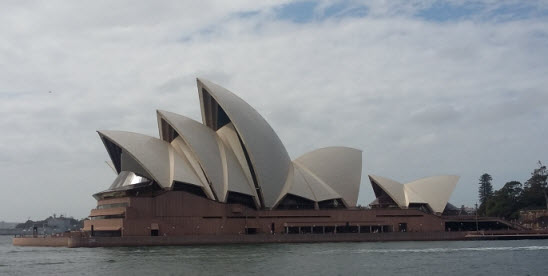
Sydney harbour walk: Quay sights and key sites
The Sydney Harbour Walk is a great way to get up close to some of the most famous and iconic spots in Australia’s largest city. The route follows the contours of Sydney Harbour from the Opera House on Bennelong Point, around Circular Quay (pronounced “key” not “kway”), under the Sydney Harbour Bridge, and past Walsh Bay before ending up at the new park at Barangaroo Reserve.
Distance
The walk as described below is just over 2 miles (3.5 kms), but since you’re in the middle of Syndey you can always jump ahead via bus, ferry, or taxi if you want.
Time
If you walked at a leisurely pace with no stops, you could finish in about an hour. However, there’s so much to see and do that you should give yourself four hours or more so that you’re not rushing toward the end.
Difficulty
The walk is completely flat and follows city sidewalks the whole way, so it’s about as easy as can be. When you reach the Barangaroo Reserve section, you have the option of either walking around or climbing up the small hill. The climb takes you to a wide flat area that offers great panoramic views of Darling Harbour and the city skyline, so it’s worth seeing if you can handle the steps and/or steep path.
Facilities
Because you’re walking a well-established urban route past tourist attractions, entertainment venues, and dining districts, you’re never far from a public toilet, a convenience store, or a park bench.
The Walk
Begin the walk at the Sydney Opera House.
Stop 1: Sydney Opera House

Officially opened in 1973, the Sydney Opera House is undoubtedly Australia’s most famous architectural wonder. Despite its name, it’s comprised of multiple performance venues, not just an opera house. In addition to guest performances, it’s home to three resident companies: Opera Australia, the Sydney Theatre Company and the Sydney Symphony Orchestra. For A$40, you can explore the complex as part of a one-hour walking tour that takes you into many of the performance spaces and provides you with great insights into the design and history of this UNESCO World Heritage Site. Tours are offered throughout the day and tickets are available in all major languages. The ticket counter is located on the ground-floor level of the complex, about halfway down on the Harbour Bridge side. Check out the official website at https://www.sydneyoperahouse.com for more details.
Stop 2: Museum of Contemporary Art Australia
After leaving the Opera House, walk along Circular Quay heading toward the Harbour Bridge. The Museum of Contemporary Art Australia is located about 100 yards past Wharf 6.
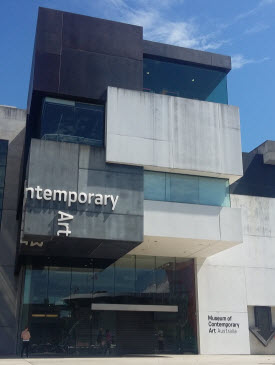
Like many people, I hate contemporary art. And every time I go to a contemporary art museum I spend most of my time saying, “I don’t get it” or “This is crap.” Which is why you should go to the Museum of Contemporary Art Australia. Because I think you will actually “get it” this time, as I did during my recent visit.
This museum is filled with lots of art spread out over three floors and I’ll admit, some of it is, in fact, unmitigated garbage. But a whole lot of it is really approachable and entertaining and amusing, as well. One example is the “Manbuynga” sculpture mural, part of which can be seen below. It takes up an entire wall in one of the gallery rooms, rising about 8 feet and stretching about 30 feet. The artist, Barayuwa Mununggurr, is from an indigenous tribe in the Northern Territory and the sculpture depicts a sacred story about the Yarrinya Ocean in which spirit men hunt their own brother, a whale called Mirinyungu.
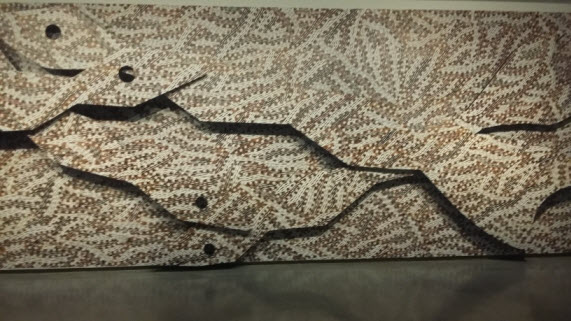
“Manbuynga” sculpture by artist Barayuwa Mununggurr
The sculpture “Soft Kiss,” by artist Sanné Mestrom is also an appealing work. It’s subtle, beautiful, and vibrant and not something you have to work hard to try to understand or appreciate.
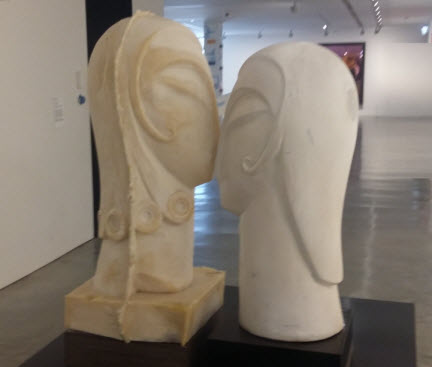
There are dozens more works that are worth taking a look at, so give it a shot. Admission to the museum is free, so if you end up disliking it, you’ve wasted only time, not money.
An added bonus: The rooftop terrace cafe offers reasonably priced, good quality lunches. As seen below, it also provides excellent views of the Harbour Bridge, Circular Quay, and, if no cruise ship is in port, the Opera House.
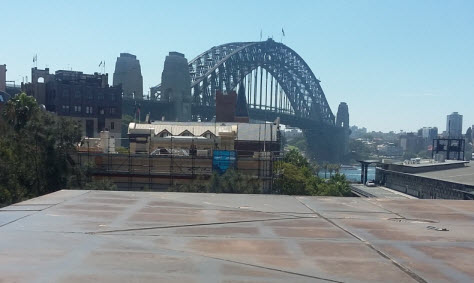
Stop 3: Captain Bligh Statue
After leaving the Contemporary Art Museum, turn left and continue walking toward the Harbour Bridge. Almost immediately, you’ll come across a small park with a statue of Captain Bligh in it.
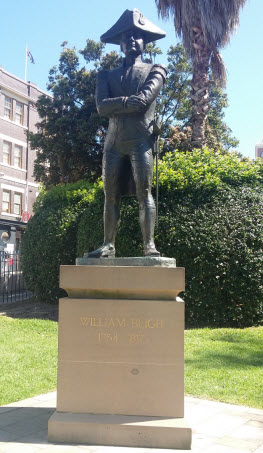
Bligh is best known for being the captain of the HMS Bounty, which experienced the most famous nautical mutiny in history at the hands of Fletcher Christian in 1789. This statue doesn’t commemorate that event or the 4,000 mile journey Bligh and his loyalists embarked on to reach the safety of the Dutch East Indies (modern-day Indonesia) after being set adrift in a small launch by the mutineers. As the plaque on the monument states, it was erected in 1987 to “restore the proper image of a much maligned and gallant man” who, among other roles, served as governor of New South Wales from 1806 to 1809.
Stop 4: Cadman’s Cottage
Just beside the Bligh Statue in the direction of the Harbour Bridge, you’ll see a small cottage set back from the footpath. This is Cadman’s Cottage, the second oldest surviving residential building in Sydney.
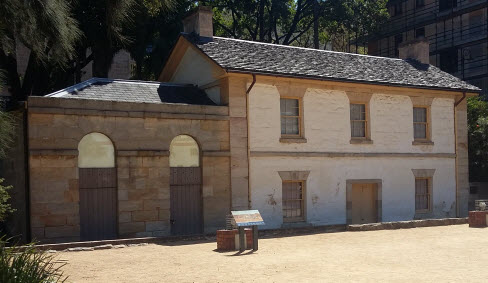
The cottage is named after John Cadman, who lived in it for 18 years while serving as Sydney’s Superintendent of Boats. The building was built in 1816 on what was then the edge of the harbor, but the shoreline was extended outward during the creation of Circular Quay in the early 19th century. The site is now approximately 250 feet from the water’s edge and is frequently dwarfed by the cruise ships that dock in front of it.
Optional Detour
If you want to visit the lookout atop the southeastern pylon of the bridge, walk back to the road that runs between the Bligh statue and the Contemporary Art Museum, and turn right. Walk up the road (Argyle Street) to the Cumberland Street overcrossing. Walk up the pedestrian Cambridge Street for about 75 yards. At the signpost, turn right and go up the stairs to Cumberland Street. When you reach it, a separate set of stair will take you up to the pedestrian pathway along the Cahill Expressway.
The Pylon Lookout is open every day except Christmas Day from 10.00am to 5.00pm. Last entry is at 4:45pm and the cost is A$15 for adults. There are three levels of exhibits within the plyon plus the outdoor lookout on the fourth level.
Stop 5: Sydney Harbour Bridge
Continue walking until you are standing under the Sydney Harbour Bridge. The bridge opened in 1932 and is nicknamed The Coathanger because of its arch-based design. At its peak, it is 440 feet (134 meters) above the water. You can climb to the top of the arch by joining a tour offered by BridgeClimb Sydney. A “Sampler” climb, that brings you halfway up the arch takes 1 1/2 hours and costs from A$168. The full climb during daylight hours costs from A$263 and takes 3 1/2 hours, which includes a safety demonstration. Dawn, twilight, and night climbs are also available, but they cost significantly more and have limited availability.
Stop 6: “Still Life with Stone and Car” Sculpture
After crossing under the bridge, the road turns left and a series of wharfs appears on the right. This area is called Walsh Bay. Continue down Hickson Road to the roundabout in front of Pier 2/3. In the middle of the roundabout is an art installation called Still Life with Stone and Car.

American artist Jimmie Durham created the work by dropping the boulder on a Ford Fiesta parked in the forecourt of the Sydney Opera House. Originally, the stone had a face painted on it but as the work has aged, the face has disappeared. Durham described his intentions in creating the work by saying:
In the first instance, I am using the stone as a tool to change the shape of an object. But I also, as usual, want to make the stone more light, more moveable, even if it is in fairly horrible way like a road accident.
— Jimmie Durham, quoted in the Walsh Bay Sculpture Walk audio file
I’ll be honest. I just don’t get this work. If you look at photos of it when it was first created in 2004, it somehow makes more sense. The car is still a car, despite the boulder that is crushing in the roof. Now, though, it just looks like scrap metal with a rock on top of it. For more information about this work and the other works that form part of the Walsh Bay Sculpture Walk, visit their website.
Stop 7: Roslyn Packer Theatre Walsh Bay
Continue down Hickson Road until you are in front of Pier 6/7. Across the street is the Roslyn Packer Theatre. It is named in honor of Australian philanthropist Roslyn Packer, widow of media mogul Kerry Packer.
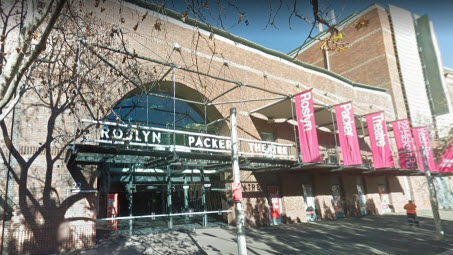
This 896 seat venue is used by the Sydney Theatre Company, the Sydney Dance Company, and the Sydney Writers’ Festival. For details on what’s on, refer to their website.
Stop 8: Barangaroo Reserve
Continue down Hickson Road until you see the entrance to Barangaroo Reserve. You can walk up the path to the summit of the hill or walk the contour of the reserve. In either event, you’ll end up at the same place. The following image is taken from the top of the hill in the Reserve.
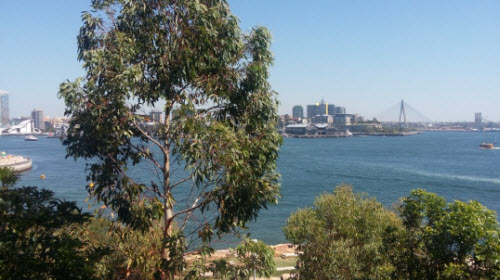
Opened in 2015, Barangaroo Reserve is a 15-acre park created on the former site of a massive shipping container facility. The following historical image of the yard is from the Barangaroo Delivery Authority website.
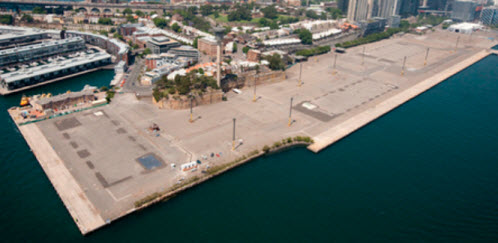
In converting the site from a sea of cement and industrial machinery to a vibrant park, the developers reconstructed the pre-1836 shoreline of this area of Sydney. This task included the planting of 75,000 native trees and shrubs. More impressively, it included the importation of millions of pounds of sandstone blocks to form the shoreline and the hill. For complete details about the project and the history of the site, refer to the Barangaroo Delivery Authority website.
Final Steps
This walk finishes on the far side of Barangaroo Reserve. Here, a massive commercial and residential development is under construction. On completion in 2024, this area will be home to Sydney’s newest neighborhood. At that point, it will finally be possible to follow the shore from Circular Quay to Darling Harbour.
At this point, you have two options. You can catch a bus back to the start or to anywhere downtown. Or you can skirt the construction site to reach Darling Harbour. The walk is about 10 minutes by foot.